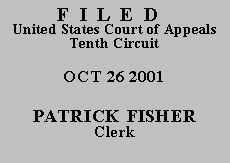

| UNITED STATES OF AMERICA, |
|
In April 1998, Mr. Gibson pled guilty to one count of conspiracy to commit armed bank robbery, two counts of armed bank robbery, and one count of using and or carrying a firearm during and in relation to a crime of violence. Mr. Gibson unsuccessfully sought to withdraw his plea and was sentenced to 181 months' imprisonment. Mr. Gibson's direct appeal was decided on May 12, 1999, United States v. Gibson, 176 F.3d 489 (10th Cir. 1999), and he did not file a petition for a writ of certiorari with the Supreme Court of the United States. On January 9, 2001, Mr. Gibson filed this habeas motion which the district court denied as untimely. Mr. Gibson appeals, arguing that he received ineffective assistance of counsel both as to his right to petition for a writ of certiorari, and as to his § 2255 claim.
On April 24, 1996, Congress enacted the Antiterrorism and Effective Death Penalty Act of 1996 (AEDPA), which requires a § 2255 movant to obtain a certificate of appealability as a prerequisite to appellate review, 28 U.S.C. § 2253(c)(2), by making a "substantial showing of the denial of a constitutional right." Where, as here, the district court dismisses the habeas motion on a procedural ground, the appellant must show that jurists of reason would both "find it debatable whether the district court was correct in its procedural ruling" and "find it debatable whether the petition states a valid claim of the denial of a constitutional right." Slack v. McDaniel, 529 U.S. 473, 484 (2000). Each of these steps is "part of a threshold inquiry" that must be satisfied before the appeals court may hear the habeas appeal. Id. at 485.
We examine first whether Mr. Gibson has made a substantial showing that the district court erred in dismissing his habeas motion as untimely. The AEDPA imposes a one-year limitation on a prisoner's right to apply for habeas relief, running from the date that the defendant's conviction becomes final. In cases where a defendant does not file a petition for writ of certiorari after the denial of the direct appeal, the one-year limitation period begins to run when the time for filing a certiorari petition expires. Unites States v. Burch, 202 F.3d 1274 1276 (10th Cir. 2000).
This court issued its order and judgment affirming the judgment on May 12, 1999. Supreme Court Rule 13.3 requires defendants to petition the Court for review on certiorari within 90 days after the denial of the direct appeal. Because Mr. Gibson did not file a timely petition for a writ of certiorari, the AEDPA's one-year statute of limitations began to run on August 10, 1999, and expired on August 10, 2000. Mr. Gibson filed his § 2255 motion on January 9, 2001, and the district court properly dismissed it as untimely.
Mr. Gibson argues that ineffective assistance of counsel precluded the timely filing of his petition for a writ of certiorari. To succeed on a claim of ineffective assistance of counsel, a defendant must show that his attorney's representation was deficient and that he was prejudiced by that deficiency. Strickland v. Washington, 466 U.S. 668, 687 (1984). There is no evidence of a deficient performance by Mr. Gibson's attorney in not filing a petition for a writ of certiorari. Mr. Gibson fails to present any evidence that he was unaware of his right to petition the Supreme Court. Nor does Mr. Gibson provide evidence of any requests to file a petition that went unanswered by his attorney.
Mr. Gibson also argues that ineffective assistance of counsel precluded timely filing of his § 2255 motion. But Mr. Gibson does not claim that he was unaware of this court's decision on direct appeal. To the contrary, evidence that Mr. Gibson presented in the form of a letter from his attorney suggests that Mr. Gibson was working on the § 2255 motion before the August 10, 2000 deadline. Mr. Gibson has no grounds for an ineffective assistance of counsel claim, since counsel is not mandated for collateral attacks. Coleman v. Thompson, 501 U.S. 722, 752 (1991).
As Mr. Gibson has not made a substantial showing that the district court erred in its procedural ruling, we need not examine whether the underlying issues raise substantial constitutional questions. Slack, 529 U.S. at 484 (encouraging appellate court to resolve procedural questions first).
We DENY a certificate of appealability and DISMISS the appeal.
Entered for the Court
Paul J. Kelly, Jr.
Circuit Judge
*. This order and judgment is not binding precedent, except under the doctrines of law of the case, res judicata, and collateral estoppel. This court generally disfavors the citation of orders and judgments; nevertheless, an order and judgment may be cited under the terms and conditions of 10th Cir. R. 36.3.
3. After examining the briefs and the appellate record, this three-judge panel has determined unanimously that oral argument would not be of material assistance in the determination of this appeal. See Fed. R. App. P. 34(a); 10th Cir. R. 34.1 (G). The cause is therefore ordered submitted without oral argument.